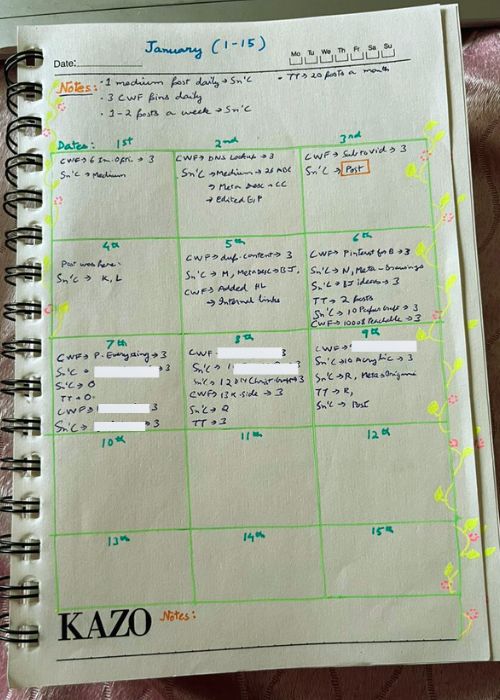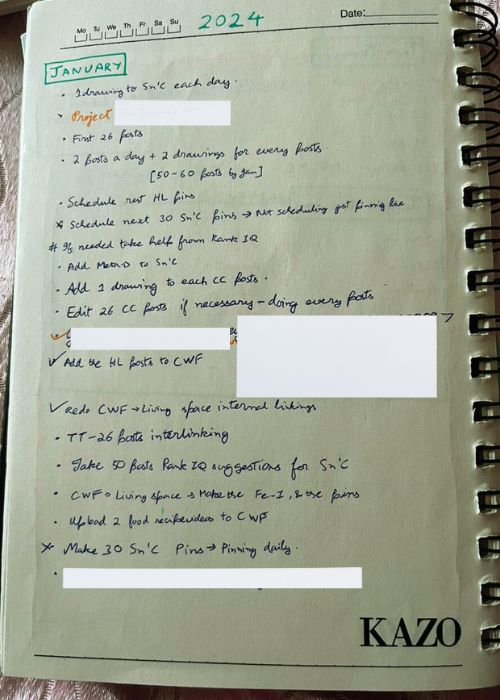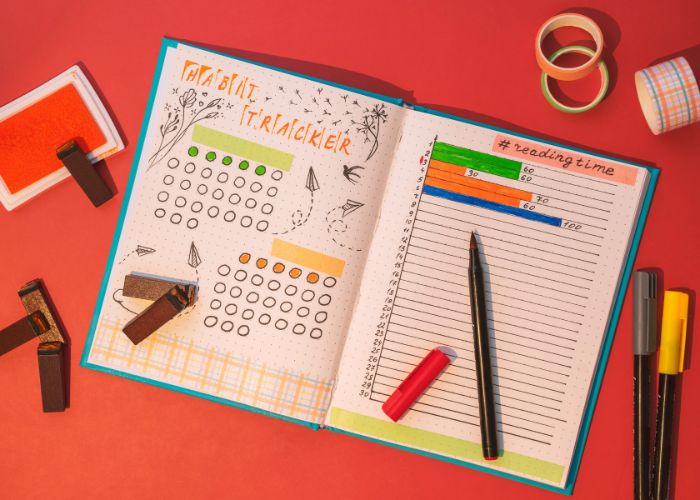Bullet Journal Mistakes: How do You fix them?
Hello, fellow journal enthusiasts! If you’ve dipped your toes into the world of bullet journaling, you know it’s a wonderfully flexible and creative way to organize your life.
But, let’s be real – we all make mistakes along the way.
Fear not! I’m here to guide you through some common bullet journal blunders and how to fix them.
Let’s turn those ‘oops’ moments into ‘aha!’ experiences.
1. OVERCOMPLICATING YOUR LAYOUT
When you start, it’s easy to get carried away with intricate layouts you’ve seen online.
But remember, the heart of bullet journaling is productivity.
If your elaborate designs are taking more time than the actual planning, it’s time to simplify.
Embrace a minimalist approach – clean lines, basic shapes, and a straightforward layout can often be more effective and less time-consuming. Remember, simplicity is the ultimate sophistication!
- Create minimalistic but effective layouts.

a. Simplifying Your Design:
The key to effective bullet journaling is functionality.
A simple layout doesn’t mean boring or uninspired; it means efficient and practical.
Start by stripping your design back to the basics.
What do you need on your page?
A space for your to-do list, a section for appointments, maybe a small area for notes? Stick to these essentials.
b. Minimalistic, But Effective Layouts:
Minimalism in bullet journaling is all about maximizing efficiency with minimal effort.
Think clean lines, basic shapes, and a restrained use of color. For instance, a simple list with checkboxes for tasks, a grid for your weekly schedule, and a small habit tracker can be both aesthetically pleasing and functional.
Use light colors or simple monochrome shades to add a touch of personality without overwhelming the page.
Another idea is to use a two-column layout:
One for personal tasks and one for work-related tasks.
This helps segregate your day and keeps your focus clear.
If you’re tracking habits or moods, a simple bar or line graph can be more effective and less time-consuming than elaborate charts.
Remember, the goal is to create a journal that helps you streamline your tasks and thoughts, not to create a work of art (unless, of course, that’s your goal!).
Your bullet journal is a tool first and foremost. Keep it simple, keep it functional, and watch your productivity soar.✍️
2. IGNORING YOUR BULLET JOURNAL’S PURPOSE
Why did you start a bullet journal?
Was it to track habits, manage tasks, or maybe for mindfulness?
It’s easy to lose track of this initial purpose. Take a moment to revisit your goals. If your journal isn’t meeting these needs, it’s time to pivot.
Set clear intentions for your journal and let them guide your layouts and content. Your bullet journal is a tool, make it work for you!
- Set clear goals for your journal.
3. INCONSISTENCY IN JOURNALING
Consistency is key in bullet journaling.
Not updating regularly? You might miss out on the full benefits.
If you find it hard to maintain a routine, try simplifying your process. Maybe you only need a weekly spread instead of a daily one.
Or perhaps setting a regular journaling time can help. The goal is to make it a habit, not a chore.
- Have a strategy to develop a consistent journaling routine.
4. GETTING CAUGHT UP IN PERFECTIONISM
Ah, the pursuit of the perfect journal! But here’s a secret – there’s no such thing as a perfect bullet journal.
It’s a reflection of real life, and real life is messy and imperfect.
Embrace the smudges and misaligned lines; they add character.
If the fear of making mistakes is holding you back, practice on scrap paper first.
Remember, your journal is your personal space – it doesn’t have to be Instagram-worthy.
- Make practice pages or embrace a more flexible attitude.
5. NEGLECTING INDEX AND KEY PAGES
Your index and key are like the map and legend of your bullet journal journey.
They’re essential for an organization.
If you’ve been skipping these, take some time to set them up. You’ll be amazed at how much easier it is to navigate your journal.
A little time spent here can save a lot of time in the long run.
- Create and maintain these essential pages.
6. OVERLOOKING THE POWER OF REVIEW PAGES
How to tell you, how important is this point? This is like being accountable to yourself.
Review pages are your moment of reflection – a time to assess what’s working and what’s not.
By not including them, you might miss the chance to adapt and evolve your journaling practice.
Dedicate a few pages at the end of each month to review your progress and set goals for the next.
It’s a game-changer!
7. USING INAPPROPRIATE MATERIALS
Ever had a pen bleed through your page? Or your marker smudging?
Choosing the right materials is crucial.
Opt for pens and markers that are journal-friendly (no bleed-through) and paper that can handle your creative flair.
It might take some trial and error, but finding the right tools will elevate your journaling experience.
- Effectively incorporate review pages.
8. COPYING OTHER’S STYLES WITHOUT PERSONALIZATION
It’s great to find inspiration from others, but remember, your bullet journal is deeply personal.
If you find yourself merely imitating others, take a step back. Experiment with elements that reflect your personality and needs.
Your journal should be as unique as you are.
- Experiment to find a unique style that works for you.
MY TAKE ON BULLET JOURNAL MISTAKES
Remember, every mistake is a stepping stone to better journaling.
Embrace your errors, learn from them, and keep evolving your practice. Your bullet journal is a personal journey, one that’s unique and ever-changing.
So, pick up that pen and keep journaling – smudges, misalignments, and all!
Related Bullet Journal Posts:
- 6 Simple Tips to Start a Mood Tracker Journal
- 10 Easy Bullet Journal Doodles to Level Up Your Pages
- How to find the perfect bullet journal theme for you?



